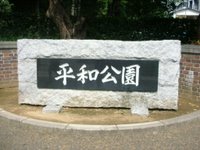Peace begins at Nagasaki
 No stay in Nagasaki is completed without a visit to the Peace Park and the Atomic Bomb Museum. Afterall, food and influences of foreign culture aside, Nagasaki city is perhaps most well-known as the 2nd city that was hit by the nuclear bomb during WWII. The Nagasaki Peace Park is built on a low hill, a little north of the hypocenter of the atomic bomb blast. It is a place of prayers for world peace and the souls of the atomic bomb victims.
No stay in Nagasaki is completed without a visit to the Peace Park and the Atomic Bomb Museum. Afterall, food and influences of foreign culture aside, Nagasaki city is perhaps most well-known as the 2nd city that was hit by the nuclear bomb during WWII. The Nagasaki Peace Park is built on a low hill, a little north of the hypocenter of the atomic bomb blast. It is a place of prayers for world peace and the souls of the atomic bomb victims.  The park features the 9.7-meter-high Peace Statue symbolizing the Nagasaki citizens' wish for peace. The raised right hand points to the heavens to signify the threat of atomic weapons while the left arm is raised horizontally to represent the wish for peace. The figure's eyes are lightly closed in prayer for the souls of the atomic bomb victims. (Information taken from Nagasaki City Tourism Guide website). Every year on August 9, the anniversary of the atomic bombing, a peace memorial ceremony is conducted in front of this statue and a peace declaration is made to the people of the world.Thus the phrase "Peace begins in Nagasaki".
The park features the 9.7-meter-high Peace Statue symbolizing the Nagasaki citizens' wish for peace. The raised right hand points to the heavens to signify the threat of atomic weapons while the left arm is raised horizontally to represent the wish for peace. The figure's eyes are lightly closed in prayer for the souls of the atomic bomb victims. (Information taken from Nagasaki City Tourism Guide website). Every year on August 9, the anniversary of the atomic bombing, a peace memorial ceremony is conducted in front of this statue and a peace declaration is made to the people of the world.Thus the phrase "Peace begins in Nagasaki".Looking at the pictures and listening to recounts of what happened on that fateful day made the afternoon a highly depressing and disturbing one. It was one thing to learn abt the tragedy from history textbooks but to be looking at remnants from the scene of the bombing and to be standing just a few hundred metres away from where the exact location the A-bomb was dropped, my travel companion and i were rather somber and deep in thoughts by the time we left the museum. As we walked along the streets in Urakami district which was completely destroyed after the bombing and looking at the city today, I cannot help but be impressed by the remarkable spirit of survival and the resilience of the people of Nagasaki.
 The Urakami cathedral that was built by the persecuted Christians in Urakami was completed in 1914. It was commemorated as Asia's leading Romanesque-style cathedral of brick construction of that time but it was partially destroyed in the atomic bombing of 1945. This building was reconstructed in 1959 and in 1980, it was remodeled with brick tiles and restored to its original appearance.
The Urakami cathedral that was built by the persecuted Christians in Urakami was completed in 1914. It was commemorated as Asia's leading Romanesque-style cathedral of brick construction of that time but it was partially destroyed in the atomic bombing of 1945. This building was reconstructed in 1959 and in 1980, it was remodeled with brick tiles and restored to its original appearance. Some pictures of Nagasaki street scene. This is taken from an overhead bridge near the Nagasaki JR station. Nagasaki is a mid-sized city with a population of abt 400,000 (that is like 10 times lesser than Singapore). There is a cheap and timely tram service and it makes for real simple easy navigation in the city.
Some pictures of Nagasaki street scene. This is taken from an overhead bridge near the Nagasaki JR station. Nagasaki is a mid-sized city with a population of abt 400,000 (that is like 10 times lesser than Singapore). There is a cheap and timely tram service and it makes for real simple easy navigation in the city. Like Singapore, it is a port city and it's surrounded by lush mountains and sea, blessed with natural deep harbour. In fact, Nagasaki is famous within Japan for its unbelievably mountainous topography. The lack of much flat land led to development of residential areas on and along its many mountains. When these houses are lighted at night,the whole port of Nagasaki twinkles and thus the name "the city with the million dollar view". I've yet to have the chance to take the ropeway up Mount Inasa for this famed view. So till then, just make do with a less than scenic picture of the houses that sprout around the hills and mountains.
Like Singapore, it is a port city and it's surrounded by lush mountains and sea, blessed with natural deep harbour. In fact, Nagasaki is famous within Japan for its unbelievably mountainous topography. The lack of much flat land led to development of residential areas on and along its many mountains. When these houses are lighted at night,the whole port of Nagasaki twinkles and thus the name "the city with the million dollar view". I've yet to have the chance to take the ropeway up Mount Inasa for this famed view. So till then, just make do with a less than scenic picture of the houses that sprout around the hills and mountains. Nagasaki JR station and Amu Plaza, shopping mall frequented by mostly young people.
Nagasaki JR station and Amu Plaza, shopping mall frequented by mostly young people.


0 Comments:
Post a Comment
<< Home